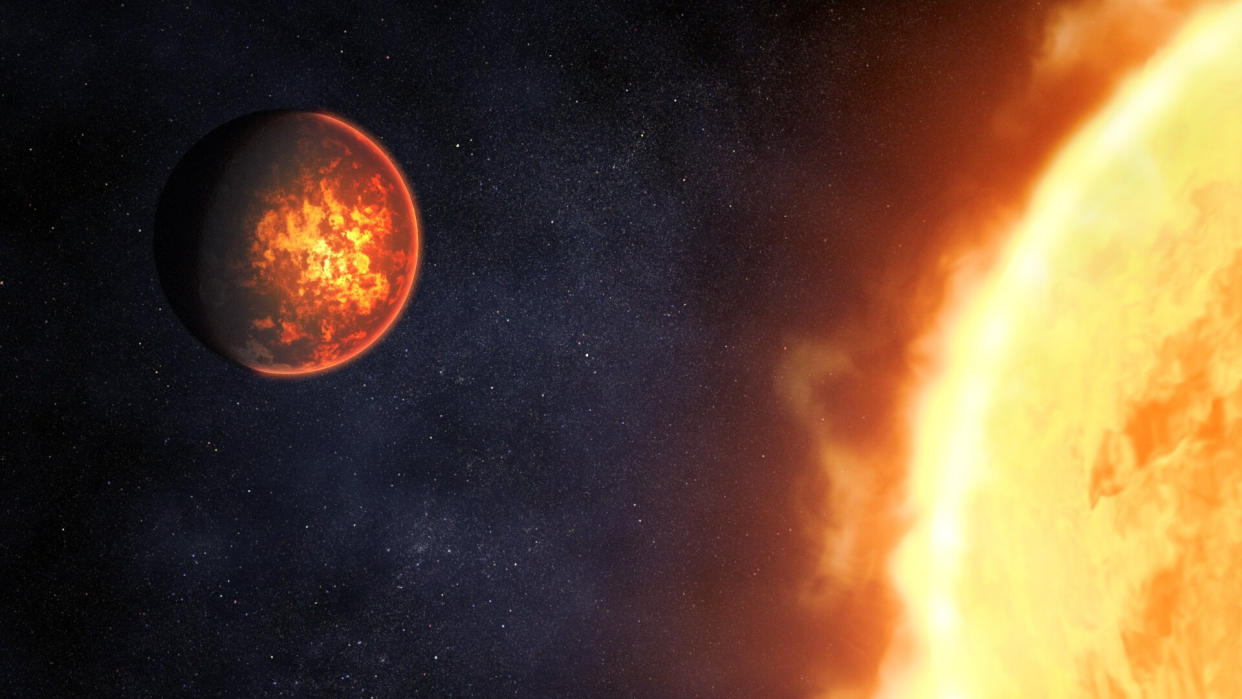The surface of this volcanic exoplanet is hotter than some stars

An exoplanet covered in so many volcanoes that its molten surface radiates a fiery red has been discovered orbiting a star 66 light-years from Earth.
That sentence may ring a bell for Star Wars fans, as Obi-Wan Kenobi indeed fought and defeated Anakin Skywalker on the lava planet of Mustafar. But, believe it or not, even that world has nothing on the newly discovered TOI-6713.01. Despite needing a catchier name, its vital statistics place it in the realm of the extraordinary.
"This is a terrestrial planet that I would describe as Io on steroids," said Stephen Kane of the University of California, Riverside, referencing Jupiter's volcanic moon, in a statement. Io is the most volcanic body in our solar system, with every inch of its surface covered in lava plains — yet it could be considered tame when compared to TOI-6713.01.
Related: Doomed egg-shaped exoplanet is death-spiraling into its star
The exoplanet, which is a super-Earth" 30% larger than our own Earth, orbits its star HD 104067 every 2.2 days at a distance of 4.57 million kilometers (2.8 million miles). It is joined by two other worlds, one being another rocky planet that sits about 15.8 million kilometers (9.8 miles) from the star and the other a gas giant planet located about 40 million kilometers (24.8 million miles) from that central anchor. Let's compare this image to our own solar system. The closest planet to our sun is Mercury, which has an elliptical, or non-circular, orbit that ranges between 46 million and 69.82 million kilometers (28.5 million to 43.3 million miles) from the sun. Yes, that means the entirety of the planetary system orbiting HD 104067 could fit inside the orbit of Mercury.
Like Mercury, the orbit of TOI-6713.01 is highly elliptical. In the case of Mercury, the planet is far enough from our sun to not really feel any effects from this barring seasonal heating; TOI-6713.01, however, is almost within touching distance of its star. It is also pulled onto an elliptical orbit due to the gravity of its two neighboring planets, forcing TOI-6713.01 to experience gravitational tides, which stretch and twist the planet's molten, malleable interior as the planet regularly orbits closer to, and then farther from, its star. Kane refers to this as a "tidal storm."
The tidal forces of the storm, in turn, heat the interior of TOI-6713.01, providing it with enough energy to cause its entire surface to erupt with volcanoes.
"It's been forced into a situation where it's constantly exploding with volcanoes," said Kane. This leads to a situation where the planet's molten surface radiates with a temperature of up to 2,600 kelvin (2,327 degrees Celsius, or 4,220 degrees Fahrenheit). To put such a temperature into perspective, that's hotter than some low-mass stars!
"This teaches us the extremes of how much energy can be pumped into a terrestrial planet, and the consequences of that," said Kane. "While we know that stars contribute to the heat of a planet, the vast majority of energy here is tidal and that cannot be ignored."
HD 104067's giant planet, which is a fifth the mass of Jupiter, was discovered in 2011 by HARPS (High Accuracy Radial velocity Planet Searcher), a prolific planet-finding instrument at the La Silla Observatory in Chile. HARPS measures the "wobble" of a star with regard to its rotational axis, as the star spins around a center of mass that it shares with its planets. The second planet in the system was also found by HARPS, as well as its counterpart HIRES (High Resolution Echelle Spectrometer), at the W. M. Keck Observatory in Hawaii. The third planet — TOI-6713.01 — wasn't spotted until Kane came to inspect observations of the star made by NASA's TESS (Transiting Exoplanet Survey Satellite) mission.
Related Stories:
— New 'warm Jupiter' exoplanet discovered by NASA's planet-hunting satellite
— Some exoplanets are shrinking. Here's why
— Star blows giant exoplanet's atmosphere away, leaving massive tail in its wake
"It was one of those discovery moments that you think, "wow, it's amazing this can actually exist,'" said Kane.
Being discovered by the transit method of exoplanet hunting, wherein the planet passes in front of its star from our perspective in the cosmos and blocks some of the light coming from its star, Kane and his team already know the diameter of TOI-6713.01. That's thanks to calculations of the amount of starlight blocked by the planet during transit. The next step is to measure the planet's mass via measurements of its star's "wobble" using HARPS and HIRES. Once its mass and radius are known, the density of TOI-6713.01 can be calculated, and this will allow Kane's team to determine how much material might be available to erupt from TOI-6713.01's many (many) volcanoes.
The findings were published on April 25 in The Astronomical Journal.

